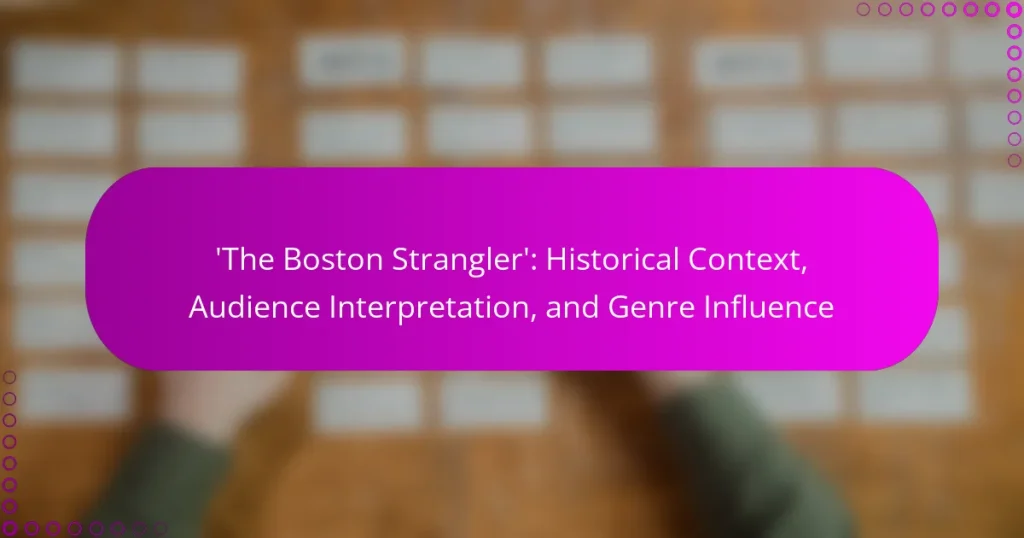The Boston Strangler refers to a series of 13 murders of women in Boston between 1962 and 1964, with Albert DeSalvo identified as the primary suspect. This case is significant for its impact on public safety, law enforcement practices, and media portrayals of crime, influencing societal perceptions of serial killers. The article examines the historical context of the Boston Strangler case, audience interpretations of DeSalvo’s character, and the genre influences in film adaptations, particularly focusing on the blending of crime, thriller, and drama elements. It highlights the cultural implications of the case and its lasting effects on discussions surrounding crime and justice in America.

What is the historical significance of ‘The Boston Strangler’?
The Boston Strangler is historically significant as it represents a pivotal moment in American crime history. The series of murders occurred between 1962 and 1964, claiming the lives of 13 women in Boston. This case highlighted issues of public safety and law enforcement’s ability to protect citizens. Albert DeSalvo was identified as the Strangler, although doubts remain about his sole responsibility for all murders. The case influenced media portrayal of crime and shaped public perception of serial killers. It also led to changes in police procedures and criminal profiling techniques. The Boston Strangler remains a cultural reference point in discussions about crime and justice in America.
How did the events surrounding ‘The Boston Strangler’ unfold?
The events surrounding ‘The Boston Strangler’ unfolded in the early 1960s. Albert DeSalvo confessed to being the infamous Strangler. He claimed responsibility for the murders of 13 women in Boston from 1962 to 1964. The victims were primarily elderly women, often found in their homes. The police faced significant pressure to solve the case due to public fear. Investigators initially pursued various leads but struggled to identify a suspect. DeSalvo was arrested in 1964 for unrelated crimes. His confession came during interrogation, leading to his conviction. Despite his admission, some doubts about his guilt remain. The case significantly impacted public perception of crime and safety in urban areas.
What were the key dates and incidents in the ‘Boston Strangler’ case?
The Boston Strangler case involved a series of murders in Boston from 1962 to 1964. The first victim, Anna Slesers, was found on June 14, 1962. The murders continued, with notable victims including Mary Mullen and Helen Blake. Albert DeSalvo confessed to the murders in 1964. He was arrested for unrelated crimes in 1964. DeSalvo’s confession was widely publicized but lacked physical evidence. He was convicted of other crimes and sentenced to life in prison. DeSalvo was murdered in prison in 1973. The case remains a significant part of Boston’s criminal history.
Who were the main figures involved in the investigation?
The main figures involved in the investigation of the Boston Strangler case were Albert DeSalvo, the primary suspect, and law enforcement officials, including police detectives and investigators. Albert DeSalvo confessed to the murders in 1964, claiming to be the Boston Strangler. His confession was central to the investigation. Key detectives included Lieutenant Detective John McGinn and Detective Sergeant Edward McCarthy, who played significant roles in the case. The investigation also involved forensic experts who analyzed evidence from the crime scenes. Their work helped establish connections between the murders.
What societal factors contributed to the notoriety of ‘The Boston Strangler’?
The notoriety of ‘The Boston Strangler’ was influenced by societal factors such as media sensationalism and public fear. In the early 1960s, Boston experienced a series of brutal murders attributed to the Strangler. The media extensively covered these crimes, amplifying public anxiety. Sensational headlines and graphic details captured widespread attention. The Strangler’s targeting of women in their homes heightened fears about safety. Additionally, societal issues like urban crime and gender dynamics played a role. The case became emblematic of broader concerns about violence against women. These factors contributed to the lasting infamy of the Boston Strangler in American history.
How did media coverage shape public perception of the case?
Media coverage significantly influenced public perception of the Boston Strangler case. Sensationalized reporting created a climate of fear among the public. Headlines often emphasized violence and terror, which heightened anxiety. Coverage frequently included graphic details of the crimes, shaping a narrative of a monstrous figure. This portrayal led to a perception of the Strangler as an almost mythical villain. The media’s focus on the case also overshadowed other aspects, such as the investigation’s complexities. Public opinion was swayed by the constant barrage of stories, leading to a rush to judgment. Consequently, the coverage played a pivotal role in framing the case’s significance in American crime history.
What impact did the case have on law enforcement practices?
The Boston Strangler case significantly impacted law enforcement practices by highlighting the need for improved investigative techniques. The case revealed deficiencies in communication among police departments. It prompted the adoption of more systematic approaches to criminal profiling. Law enforcement agencies began to prioritize collaboration and information sharing. The case also led to advancements in forensic science and evidence collection methods. As a result, police training programs incorporated lessons learned from the case. These changes aimed to enhance the overall effectiveness of criminal investigations. The case underscored the importance of public awareness and community involvement in crime prevention.

How has ‘The Boston Strangler’ been interpreted by audiences over time?
‘The Boston Strangler’ has been interpreted by audiences as a complex figure embodying fear and intrigue. Initially, the case generated widespread panic in the early 1960s. Many viewed the Strangler as a symbol of urban danger. Over time, interpretations shifted towards psychological analysis of the killer, Albert DeSalvo. Documentaries and films have explored his motivations and societal impact. Audiences have reacted with a mix of horror and fascination. The case has also sparked discussions on media sensationalism. Academic studies have analyzed the portrayal of crime in popular culture, reflecting changing societal attitudes.
What themes do audiences associate with ‘The Boston Strangler’?
Audiences associate several themes with ‘The Boston Strangler.’ Key themes include fear, violence, and the complexities of criminal psychology. The fear theme arises from the terror instilled in the Boston community during the killings. Violence is a prominent theme due to the brutal nature of the crimes committed. The complexities of criminal psychology are highlighted through the exploration of the mind of the murderer. Additionally, themes of media sensationalism and the impact on public perception are evident. These themes reflect societal anxieties and the fascination with true crime narratives. The historical context of the case further amplifies these themes, as it occurred during a time of social upheaval in the 1960s.
How do different generations perceive the events of ‘The Boston Strangler’?
Different generations perceive the events of ‘The Boston Strangler’ through varying lenses shaped by their historical context. Older generations often view the case as a significant crime that highlighted societal fears of urban violence in the 1960s. They recall the media frenzy and the impact of the murders on public safety perceptions.
Younger generations, however, may see the events as part of true crime entertainment, influenced by documentaries and dramatizations. They focus more on the psychological aspects and the sensationalism surrounding the case.
The generational divide also reflects changes in media consumption. Older individuals may have experienced the news through traditional outlets, while younger audiences engage with digital narratives. This shift alters the emotional resonance and analytical perspectives on the case.
Overall, the perception of ‘The Boston Strangler’ varies significantly across generations, influenced by historical context, media representation, and individual experiences.
What emotional responses does ‘The Boston Strangler’ evoke in viewers?
‘The Boston Strangler’ evokes feelings of fear, anxiety, and fascination in viewers. The film portrays the chilling story of a notorious serial killer, which can lead to heightened tension. Viewers may experience fear due to the graphic depiction of violence. Anxiety arises from the uncertainty of the killer’s next move. Fascination often stems from the psychological exploration of the killer’s motives. The film’s suspenseful pacing adds to these emotional responses. Historical context amplifies the impact as the story is based on real events. This connection to reality can intensify fear and anxiety. Overall, the film effectively elicits a complex emotional reaction from its audience.
How have adaptations of ‘The Boston Strangler’ influenced audience interpretation?
Adaptations of ‘The Boston Strangler’ have significantly influenced audience interpretation by framing the narrative around psychological complexity and societal fears. The 1968 film adaptation emphasized the duality of Albert DeSalvo, portraying him as both a monster and a victim of his circumstances. This portrayal shaped public perception, leading audiences to grapple with themes of morality and mental illness.
Subsequent adaptations, including documentaries and dramatizations, further explored the impact of media sensationalism on public understanding of crime. They often highlighted how media narratives can distort reality, creating a lasting impact on societal views regarding serial killers.
Research indicates that these adaptations have contributed to a cultural fascination with true crime, altering how audiences engage with criminal narratives. The blending of fact and fiction in these adaptations has blurred the lines of reality, prompting viewers to question the reliability of their sources. Overall, adaptations have shaped a more nuanced understanding of crime and its portrayal in society.
What are the notable films and documentaries about ‘The Boston Strangler’?
Notable films and documentaries about ‘The Boston Strangler’ include “The Boston Strangler” (1968), starring Tony Curtis. This film dramatizes the life of Albert DeSalvo, the man believed to be the Strangler. Another significant documentary is “The Boston Strangler: The Untold Story” (2013), which explores the case in detail. Additionally, “The Real Boston Strangler” (2007) presents interviews and evidence surrounding the infamous killings. These works contribute to the understanding of the historical context and impact of the case.
How do these adaptations differ in their portrayal of the case?
The adaptations of “The Boston Strangler” differ significantly in their portrayal of the case. Each adaptation emphasizes different aspects of the crimes and the perpetrator. For instance, some portrayals focus on the psychological profile of Albert DeSalvo, while others highlight the media frenzy surrounding the case. The 1968 film presents a dramatized version of events, emphasizing sensationalism. In contrast, later adaptations may aim for a more factual representation, incorporating real police records and interviews. This variance affects audience perception, shaping how the public understands the complexities of the case. Each adaptation’s approach reflects the cultural context and genre influences at the time of its release.

What genre influences can be traced to ‘The Boston Strangler’?
The genre influences traced to ‘The Boston Strangler’ include crime, thriller, and drama. The film portrays a real-life serial killer, which aligns with the crime genre. It explores psychological elements, typical of thrillers, creating suspense and tension. Additionally, the dramatic portrayal of events emphasizes the emotional impact on victims and society. The film’s narrative structure follows a documentary style, enhancing its realism. This blend of genres reflects societal fears during the 1960s about crime and safety. The film’s influence can be seen in subsequent true crime adaptations, which often combine similar elements of drama and suspense.
How has ‘The Boston Strangler’ shaped the crime genre in film and literature?
‘The Boston Strangler’ has significantly influenced the crime genre in film and literature. The case introduced a raw, psychological complexity to portrayals of serial killers. It shifted narratives from mere crime stories to explorations of the criminal mind. Films like ‘The Boston Strangler’ (1968) dramatized the real events, emphasizing the moral ambiguity of justice. Literature began to reflect similar themes, focusing on the societal impacts of crime. This case also inspired a wave of true crime literature that sought to analyze criminal behavior. The blending of fact and fiction in these works created a new narrative style in the genre. Overall, ‘The Boston Strangler’ set a precedent for deeper character studies in crime storytelling.
What conventions of the crime genre are exemplified by ‘The Boston Strangler’?
‘The Boston Strangler’ exemplifies several conventions of the crime genre, including the focus on real-life events and psychological profiling. The film is based on the true story of Albert DeSalvo, who was identified as the infamous serial killer. This adherence to factual events is a hallmark of crime narratives.
Additionally, the film explores the psychological motivations behind the crimes, a common element in crime stories. It delves into DeSalvo’s troubled psyche, showcasing how his background influenced his actions. The use of law enforcement procedures and investigations is also prominent. The film depicts police efforts to capture the Strangler, highlighting the procedural aspect of crime-solving.
Moreover, the narrative structure often includes suspense and tension, keeping the audience engaged. The film effectively builds a sense of dread and curiosity about the killer’s identity. It also addresses societal fears around safety and morality, reflecting broader cultural anxieties during the time it was released.
These conventions collectively contribute to the film’s classification within the crime genre, offering a blend of factual storytelling and psychological exploration.
How do modern crime narratives draw inspiration from ‘The Boston Strangler’?
Modern crime narratives draw inspiration from ‘The Boston Strangler’ through their exploration of psychological profiling and complex character development. The case introduced a focus on the mind of the criminal, influencing how narratives depict motives and psychological states. Filmmakers and writers often reference the sensational media coverage surrounding the Strangler, which shaped public perception and narrative style. Additionally, the blending of fact and fiction in stories about the Strangler has inspired similar techniques in contemporary works. The Strangler’s case remains a touchstone for themes of fear, morality, and societal response to crime, making it a recurring reference point in modern storytelling.
What role does ‘The Boston Strangler’ play in the evolution of true crime storytelling?
The Boston Strangler significantly influenced true crime storytelling by shaping public fascination with serial killers. This case highlighted the psychological aspects of crime, driving deeper narratives in true crime literature and media. The media’s extensive coverage established a template for sensationalized reporting on criminal cases. This reporting often focused on the perpetrator’s background and motives, which became a hallmark of the genre. The Boston Strangler also raised questions about law enforcement’s effectiveness, prompting discussions about criminal justice and societal fears. This case’s legacy continues to affect how true crime is approached today, blending factual reporting with psychological analysis.
How has the portrayal of serial killers in media changed since ‘The Boston Strangler’?
The portrayal of serial killers in media has evolved significantly since ‘The Boston Strangler.’ Earlier representations focused primarily on sensationalism and fear, emphasizing the brutality of the crimes. ‘The Boston Strangler’ film in 1968 highlighted the psychological aspects of the killer, introducing a more complex narrative.
In recent years, media portrayals have shifted towards exploring the psychological backgrounds and societal influences on serial killers. Documentaries and series now often provide in-depth analyses, attempting to understand the motivations behind the crimes.
This change reflects a broader trend in media to humanize subjects, moving away from mere sensationalism. For instance, shows like ‘Mindhunter’ and documentaries like ‘The Ted Bundy Tapes’ delve into the psychological profiles of killers.
Additionally, there is a growing emphasis on the impact of these crimes on victims and communities, rather than glorifying the killers. This nuanced approach aims to foster a deeper understanding of the complexities surrounding serial violence.
What lessons can be learned from the narrative techniques used in ‘The Boston Strangler’ adaptations?
The narrative techniques used in ‘The Boston Strangler’ adaptations teach important lessons about storytelling. They demonstrate the effectiveness of non-linear narratives in building suspense. Flashbacks are utilized to reveal character motivations and backstory. This technique deepens audience engagement and understanding. The adaptations also show the power of perspective shifts. Different viewpoints can create a more complex narrative. Additionally, the use of documentary-style elements enhances realism. This approach can evoke a stronger emotional response from viewers. Overall, these techniques highlight the importance of innovative storytelling in crime narratives.
What can we learn from analyzing ‘The Boston Strangler’ in a contemporary context?
Analyzing ‘The Boston Strangler’ in a contemporary context reveals insights into societal fears and media influence. The case highlights how sensationalism can shape public perception of crime. It also illustrates the complexities of criminal psychology and the challenges of law enforcement. Furthermore, it reflects on the evolving discourse around mental health and criminal responsibility today. The portrayal of the Strangler in media showcases the impact of narrative framing on audience interpretation. This case serves as a cautionary tale about the dangers of stigmatizing mental illness. Understanding these dynamics can inform current discussions on crime, justice, and media ethics.
The Boston Strangler is a historically significant entity in American crime history, representing a series of murders that occurred in Boston from 1962 to 1964, claiming the lives of 13 women. The article explores the events surrounding the case, the key figures involved, and societal factors that contributed to its notoriety, including media sensationalism and public fear. It also examines the impact of the case on law enforcement practices, audience interpretations across generations, and its influence on the crime genre in film and literature. Furthermore, the article analyzes how adaptations of the case have shaped public perception and the evolution of true crime storytelling.


